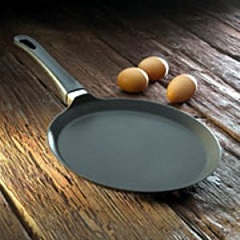|
Titanium nonstick cookware – the truth behind the fancy name
“If people would stop buying things they don’t need, with money they don’t have, then we’d all be screwed”. I don’t remember who said this, but I think we all found that the current economic crisis is a sad proof of the truth of these words. And there is even a deeper meaning of this, a terrible and inherent flaw of the market mechanism that hasn’t been addressed yet, which I suspect is highly responsible for the current downturn trend of the global economy. You see, when the first Blade movie) came out, we all saw Wesley Snipes wielding an "acid etched titanium sword", a cool fantasy device that would not really work off screen, as a titanium blade would loose its sharpness very quickly. Yet, very soon, several major cutlery produces began marketing titanium knives, embellishing titanium properties and, of course, demanding higher than average prices for their merchandise, based on these properties. In fact, titanium and titanium alloys really have no practical place for knives, unless you really need the acid resistance for cutting those sulfuric acid infused tomatoes all day long. And now we return to the matter at hand, titanium nonstick cookware. There is an ongoing controversy in the cookware market regarding the nonstick appliances as several recent studies pointed out that the polymer composite coating that were traditionally used for the nonstick properties allegedly release compounds that can potentially be harmful when ingested. 
I have no doubt that all the major producers ensue all the testing necessary to make sure that the products they market are completely safe and do not generate harmful effects in their interaction with the final purchaser. This being especially true for companies involved in sensitive areas such as health, beauty care, or cooking. But no laboratory and field testing has the capacity of simulating every possible situation that is likely to happen when a product is put to real use, in millions of homes that create a indefinite variety of environment and stress factors. So, it is very likely that in certain conditions, some products may indeed potentially release those toxic compounds as the studies suggested.
Titanium’s only rational use in cookware is for backpacking cookware, where every ounce counts, and where titanium’s unmatched strength to weight ratio really shines.
Return from Titanium nonstick cookware to Titanium Cookware Return to Titanium Home Page
|


